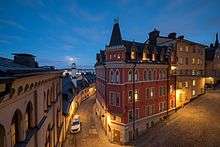Nordic Noir
Nordic Noir is, in its most general sense, crime fiction from, or set in, the Nordic countries. It has been appreciated outside its homeland for its spirit of cynicism, melancholia and angst. Most of the stories are set in real-life places, open to visit. The dark style and often brutal nature of the crimes described is arguably inspired by the wide open spaces with nary a person in it and the long dark cold winters at high latitudes.
| Nordic countries: Denmark, Finland, Iceland, Norway, Sweden Vikings and the Old Norse • History • Sami culture • Winter • Right to access • Boating • Hiking • Cuisine • Music • Nordic Noir |
Understand

| “ | - What happened when you were twelve? I'm sorry, that's none of my business. - I tried to kill my father. Burned him alive. Got about eighty percent of him. - Oh. - I made some coffee. |
” |
—Stieg Larsson, The Girl with the Dragon Tattoo | ||
The Nordic countries have had a prolific crime fiction scene since the mid-20th century. In the 1990s it got international attention, with cinematics of the Martin Beck stories, and the Danish Pusher series. Nordic Noir differs from British country-house detective stories and Hollywood crime fiction. While inspired by film noir, the exteriors are more often rural than urban, with the femme fatale usually replaced by an independent heroine. The stories are usually police procedurals, but in some cases (such as Pusher) told from the criminal's point of view. Nordic Noir enjoys a particular avid fanbase outside its native Scandinavia in Germany and both German language translations and works by German authors in a similar style (sometimes even set in the Nordic Countries) are widely available.
Destinations
- 🌍 Stockholm, Sweden. Location of many Nordic Noir works, such as the Millennium (The Girl with the Dragon Tattoo) series, the Martin Beck franchise, and Let the Right One In.
- 🌍 Stockholm Court House (Stockholms Rådhus). The courthouse from the turn of the century with its massive tower is regarded as one of the foremost examples of Swedish national romanticism architecture, with a successful 2000s restoration. Open to public at weekdays; security checkpoint at front door. Open to the public, in contrast to the nearby police headquarters.
- 🌍 Bellmansgatan (Södermalm, Stockholm). This street is the setting of much of the Millennium series (as Lisbeth and Mikael's home), and has a spectacular view of central Stockholm. Some scenes were shot at the rundown traffic hub Slussen; which has been torn down during the 2010s.
- 🌍 Blackeberg (Bromma, Stockholm). A 1950s suburb which used to be rather anonymous until it became the setting for the vampire film Let The Right One In.
- 🌍 Ystad, Sweden. Home of Detective Wallander.
- 🌍 Copenhagen, Denmark. Location for Nordic Noir works such as the Pusher series, The Killing, and The Bridge
- 🌍 Nørrebro (Copenhagen, Denmark). A working-class neighbourhood which is the setting of the Pusher series and other works.
- 🌍 Lillehammer, Norway. Setting of Lilyhammer.
- 🌍 Öresund-Bridge. An important setting of the international crime drama "the Bridge" subsequently copied/remade as a French/English series with the Chunnel as its basis and a less successful US/Mexican version
- 🌍 Borgafjäll (Dorotea, Västerbotten County). Setting of Black Lake ("Svartsjön").
Go next
As mentioned above, Germany also loves crime fiction and besides the affinity towards Nordic Noir, the domestic series "Tatort" and "Polizeiruf 110" (originally a GDR production in response to West German Tatort) are particularly popular and notable for their style where the setting is often rather central to the plot with local landmarks prominently displayed even when most of the actual shooting takes place in studios or other cities.
See also
- Astrid Lindgren tourism; Astrid Lindgren authored Kalle Blomkvist, a boy detective whose name was lent to the Millennium protagonist, Kalle Blomkvist